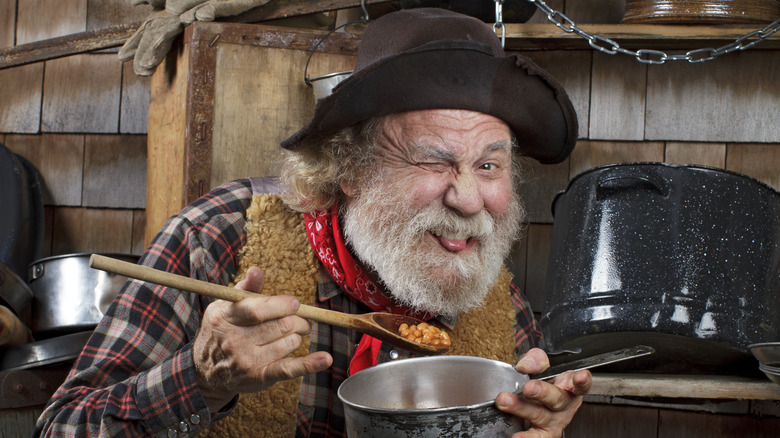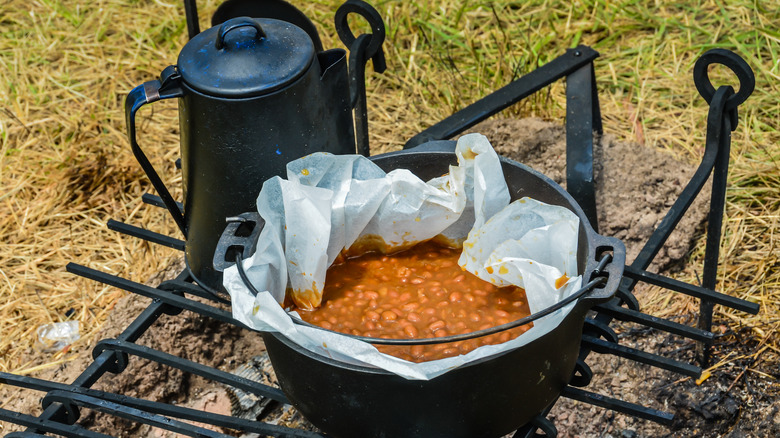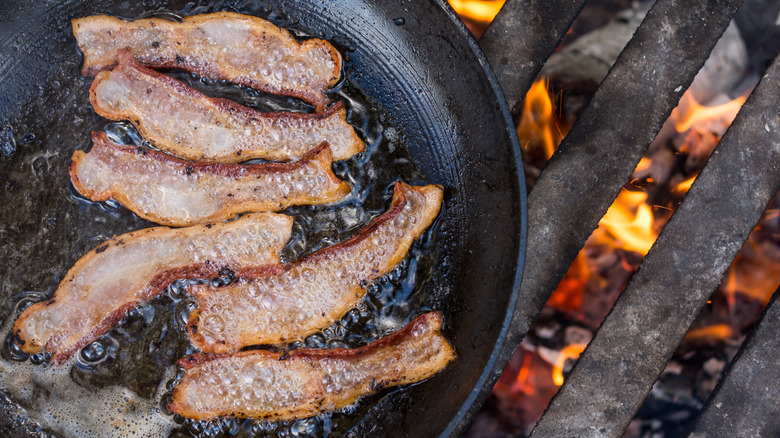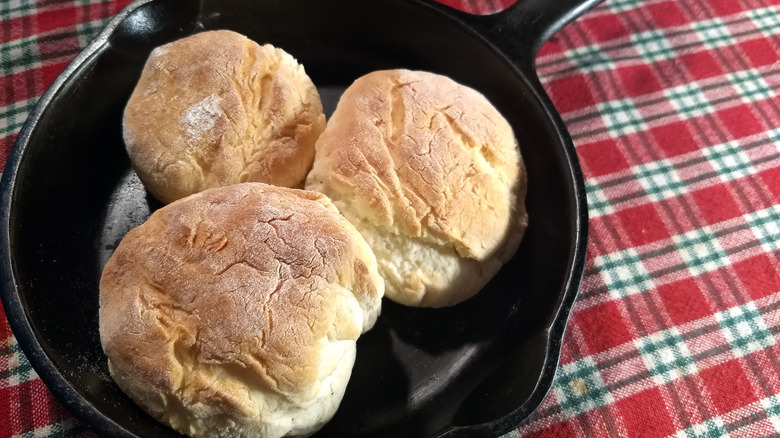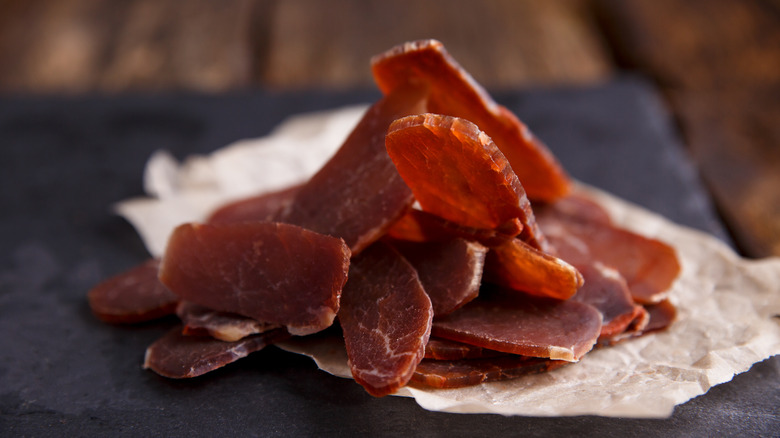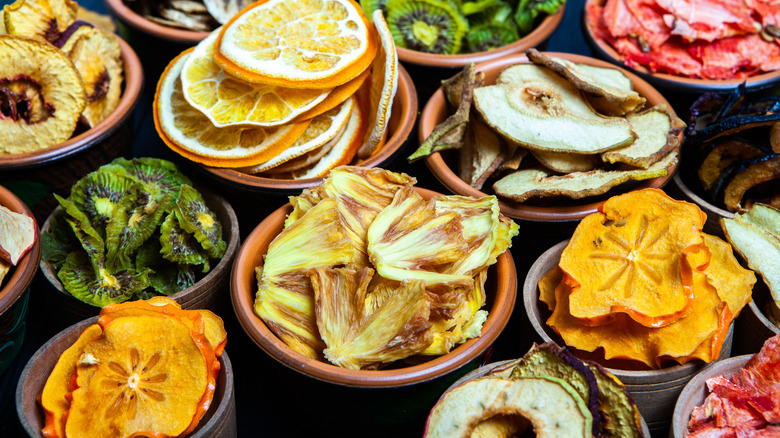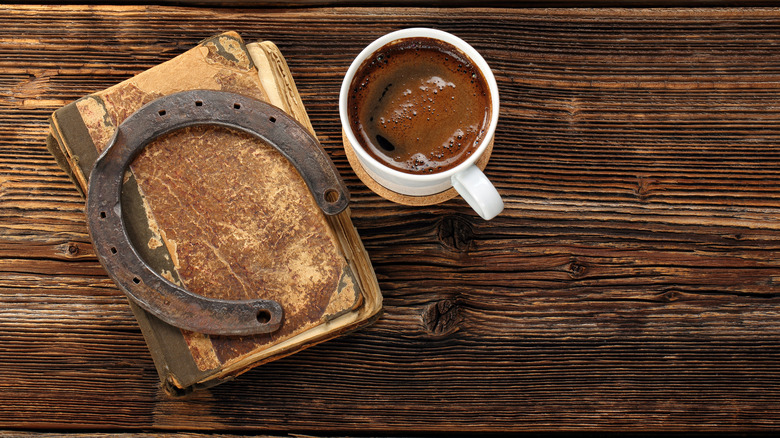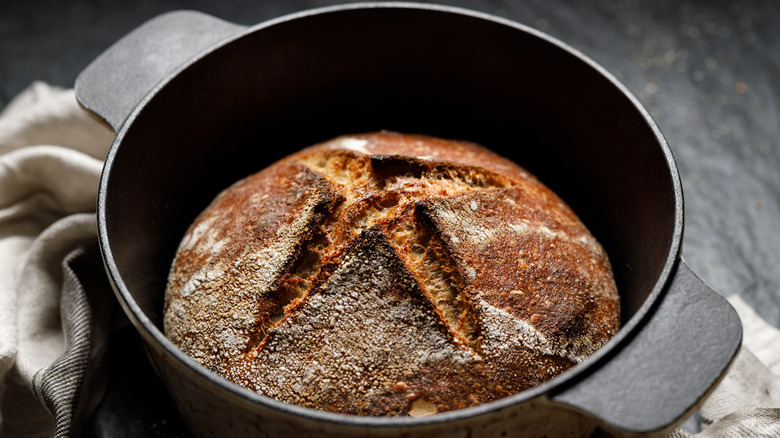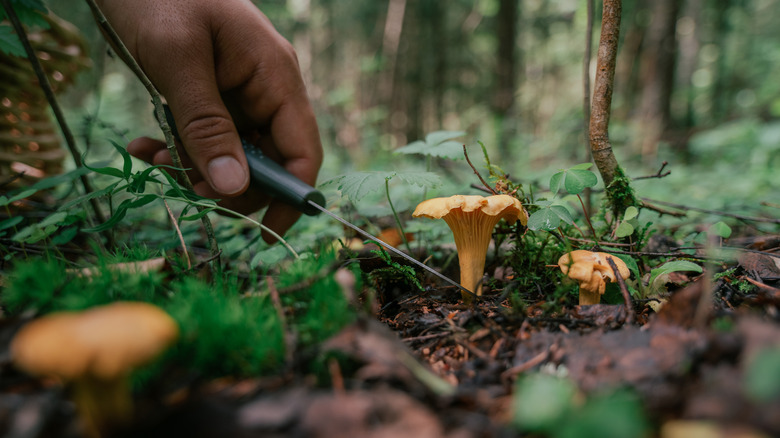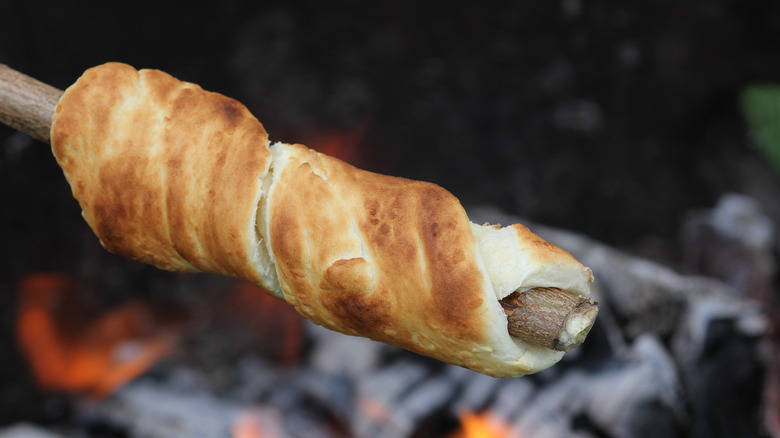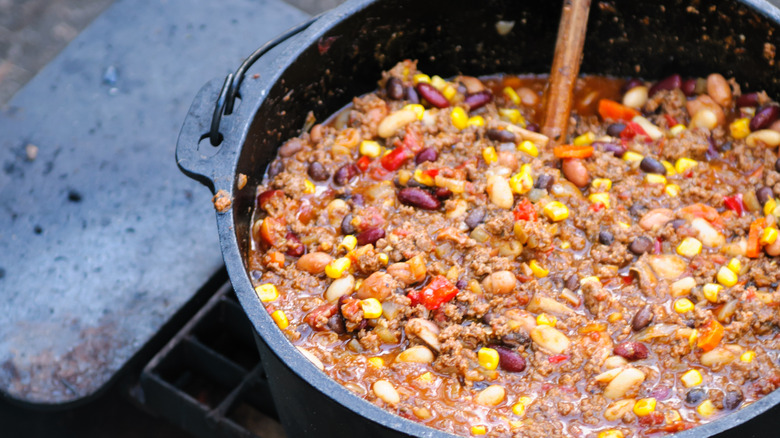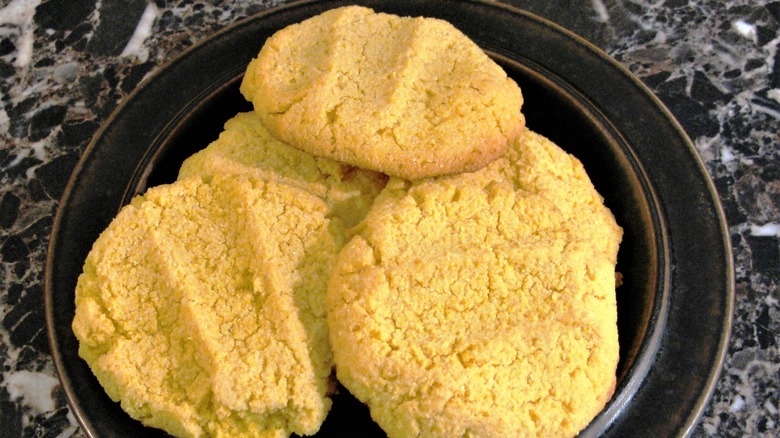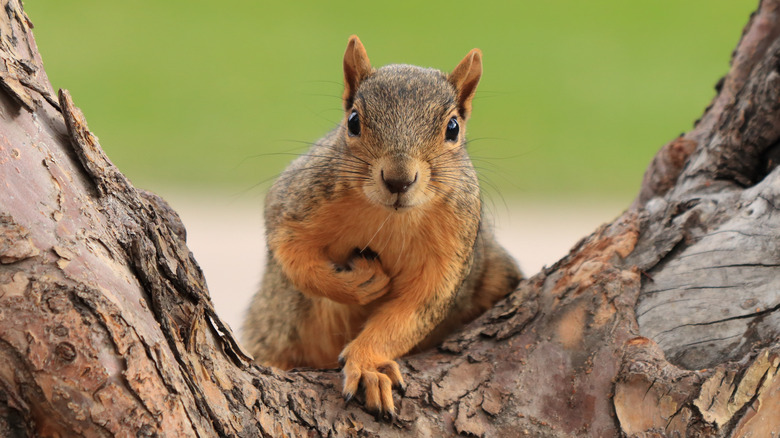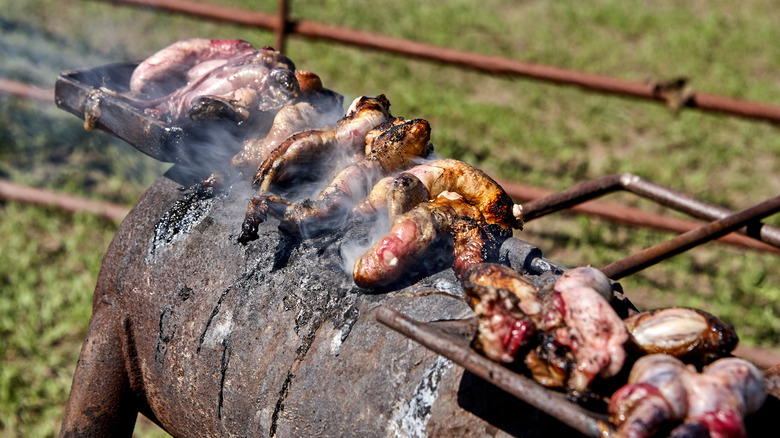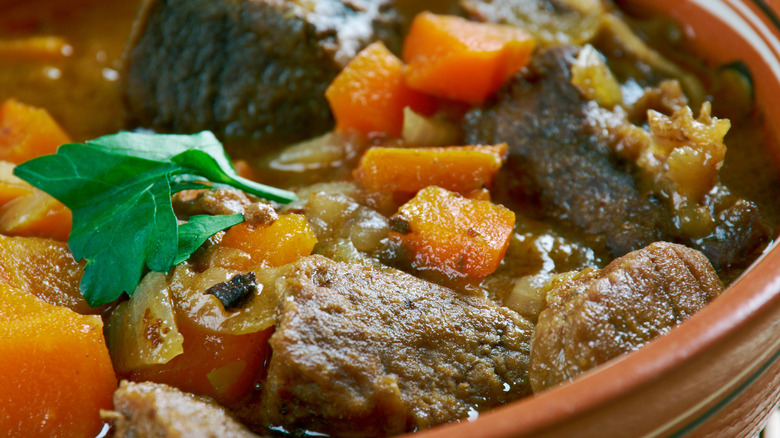What Did Cowboys Really Eat In The Old West?
When you think of cowboy food, what comes to mind? For many of us, it's a tired and dusty cowhand sitting by the fire with a pot of beans and a cup of coffee. Though beans and coffee were staples of their diet, a cowboy's daily meals weren't always as mundane as you might think, especially for anyone who rode with a chuck wagon.
The term "chuck wagon" is a Southern term, according to America Eats (via Montana State University). It was known as the "mess wagon" on the Dakota prairies. The Dutch oven was often the preferred cooking tool. The cook held great power, meaning that cowboys would do favors for the cook so they could get a little extra food in the evenings. The cook had so much influence in the group that even the mighty trail boss often deferred to him.
According to Legends of America, the cook (or Cookie, as he was sometimes called) brought easy-to-preserve items in the wagon, such as beans, cured meats, coffee, lard, and potatoes. Because they were driving cattle, beef was readily available, but many also hunted and foraged along the way. So, what did the trail drive's VIP do to keep hungry cowboys fed and morale high? Here's what Cookie served up on a regular basis.
Beans
Pinto beans were the primary choice of cooks on the trail, according to True West. However, other varieties such as kidney beans and white beans were likely used. Lightweight dried beans are highly portable and could soak all day in the wagon, making prepping them fairly simple in the evenings once the crew had settled down for the night. Additionally, dried beans keep for a long time and are an excellent source of protein, making an incredibly filling meal for cowboys out on the range.
The downside, however, is that beans generally had to be eaten right away. Without any reliable source of refrigeration, there was no way to keep them from going sour after they were cooked.
While plain old beans may not sound appetizing, the cook had a few tricks up his sleeve. Beans were often cooked with chili peppers to add spice and flavor. The University of Arkansas Division of Agriculture speculates that beans and rice were likely added to "a bowl of red," otherwise known as chili, to make the meal stretch further. After all, feeding up to 20 ravenous cowboys at a time meant that a cook had to be seriously efficient.
Salt pork and bacon
Cowboys enjoyed pork often in the form of salt pork (sometimes called sowbelly) and bacon. According to the Tar Heel Junior Historian (via NCpedia), pork was a staple food from the days of the early settlers through the mid-1900s, as it was easy to produce in large quantities.
So, what is the difference between bacon and pork belly? Pork belly comes from the fatty underbelly of the pig (per MasterClass). So does bacon. But sowbelly is a thick slab of meat that's high in fat, tender, and uncured. Bacon is usually a type of pork belly, but it's sliced into thin strips, though it may also come from other parts of the pig.
Without refrigeration, meat that the cowboys ate had to be preserved in some way. Cowboys were always on the move, so old-fashioned methods of refrigeration wouldn't work. That's where salting comes in. Salting meat to dry and preserve it has been around for centuries. The simplest form of salting meat is to lay out the pieces of sowbelly on a layer of salt and then cover it with more salt, leaving it there until the meat has dried. Another method of salting mentioned in "Miss Beecher's Domestic Receipt Book," published in 1846, involved layering salt and pork in a barrel until it was full, then soaking it all in pickle brine.
Hard biscuits
While the term "hot rocks" may sound like a bunch of stolen gems, it's actually a biscuit — an incredibly hard biscuit that's been baked to remove every last drop of moisture. According to Bushcraft Buddy, they were made with only flour, water, and salt. The cowboy cook baked the biscuits multiple times until they were rock hard, hence the term "hot rocks." The results remained edible for years, but that doesn't mean they were tasty. These hard and brittle pieces of bread were softened and made more palatable by adding liquid, such as water or milk.
Also known as hardtack, this type of bread was a staple for soldiers during the Civil War. According to the National Parks Service, soldiers sometimes mashed the bread with their rifle stocks to mix it into stew. It could also be soaked in water and fried in bacon fat or lard before serving. Dunking the "sheet iron crackers" in coffee was common practice, too, for a couple of reasons. First, it softened up the bread. Second, the hot temperature helped kill the maggots and worms that permeated the hardtack. Once the bugs were skimmed off the top, the soldiers could enjoy their coffee and bread.
Beef
Beef jerky helped cowboys sustain their energy on long cattle drives. They enjoyed other types of jerky produced with different meats, too. According to History Hit, smoked beef jerky was the most common way cowboys consumed beef, given that it lasted longer than fresh beef and it could be added to stews.
By the late 1800s when the cowboy era was in full swing in the American West, jerky had been around for a very long time — hundreds of years, in fact. In those days, jerky was made by using a variety of techniques to cure, smoke, and dry the meat (per North Dakota State University Extension). The sun, smoke, wind, and salt were all methods that were used to create this shelf-stable meat. Florida Raised reports that beef jerky is made nearly the same way today, but the cowboy version was drier, more brittle, and much saltier.
Native Americans had also been making pemmican — bars made from dried meat like venison or bison, nuts, berries, and suet — for centuries (per North Carolina Cooperative Extension). The cowboys enjoyed them, too, since it was a popular trading product when indigenous people crossed paths with cowboys.
Dried fruit
Dried fruit was a must-have for any well-equipped chuck wagon. It helped to liven up the usual fare, providing something sweet along with the more savory slate of beans, meat, and bread. As with many other frontier foods, most common method of preserving fruit back then was to dry it. This was typically achieved by placing fruit in the sun on cheesecloth and letting it shrivel up and harden, according to PBS.
It was common for the cook to stew dried fruit in the morning for breakfast, or to serve it as a dessert in the evening. Pies were also made from stewed fruit. To make the fruit taste better, it was sometimes soaked in water and stewed with sugar.
America Eats (via Montana State University) included remarks from two cowboys who especially loved a pudding made with raisins, currants, flour, sugar, and a few other staple ingredients that were boiled together in a sack. It was served with a variety of sauces, including one made with dried apples and currants.
Coffee
Coffee was the lifeblood of cowboys. Many of us today feel the same, but could we guzzle down the coffee they drank? Probably not. Long days of hard work required a strong cup — not the stuff we drink today that's loaded with milk or cream or watered down to make it more palatable. They needed the invigorating power of straight black, piping hot coffee. The cowboys' preferred drink of choice? Arbuckle's, of course.
While Folgers may have been the King of Coffee for those taking part in the California gold rush, cowboys in the southwest preferred Arbuckle's (per HistoryNet). In fact, the Arbuckle's name was as synonymous with coffee then as Kleenex is with tissues today. Its popularity may have had something to do with all the extras packed with the coffee. Every package had coupons and, more importantly, included a stick of peppermint candy. For hungry cowboys, that meant that the one who ground the beans got the peppermint. That was quite a treat in the Old West!
Chuck wagon cooks squeezed every drop of caffeine and flavor they could out of their coffee, piling fresh grounds on the old ones before boiling away. If you're wondering just how strong the cowhands liked their java, this recipe from "Western Words" tells the tale: "Take two pounds of Arbuckle's coffee, put in 'nough water to wet it down, boil it for two hours, then throw in a hoss shoe. If the hoss shoe sinks, she ain't ready."
Sourdough
Besides coffee and a Dutch oven, a chuck wagon cook's greatest asset on the range was his sourdough starter. True West notes that while cowboys gathered around the campfire every evening to tell tall tales, Cookie was often tending to his sourdough starter. This was before active dry yeast was produced commercially by Fleischmann's in 1943 (per Chicago Tribune). Before that, many made sourdough bread, which uses wild yeast to achieve its signature tangy flavor.
Cowhands preferred sourdough biscuits over buttermilk and baking powder biscuits, according to the Cowboy Professor at North Carolina State University. Sourdough was also used to make flapjacks, says True West.
According to Taste, the attention-hungry sourdough starter is a mixture of flour and water that absorbs yeast and bacteria from its environment. The type of flour you use in your sourdough starter is very important, as is cleanliness. Clean jars and filtered water are required to prevent harmful bacteria from growing. On the first day, a baker like Cookie would need to carefully combine all-purpose and wheat flour with some water. The resulting mixture is then "fed" daily with a mixture of starter, water, and more flour. Neither Cookie nor you would need to feed the starter more than once a week once you get the hang of feeding and storing it.
Foraged plants
Having limited storage space in the chuck wagon, cowboys had to rely on foraged plants and wild game to supplement the usual fare. Cowboys learned to identify plants from indigenous people and other, more experienced cowhands, according to Ask a Prepper. As they were constantly moving, they altered their diets based on the wild plants available in the area.
Berries were always welcome, since they could be used along with or instead of dried fruits to make pudding and pie. When available, wild grapes, blackberries, currants, elderberries, wild strawberries, and blueberries were gathered along the trail. Cattle drives began in the spring when grass was plentiful for the moving herd, according to Texas Almanac. It also coincided with berry-picking season (per Shari's Berries), which is generally late spring to early fall.
For the cowboys, foraged nuts were an essential source of protein. They were roasted over a fire and enjoyed with whiskey, according to Ask a Prepper. Cowhands enjoyed acorns, pine nuts, and other tree nuts. For seasoning food, wild herbs like sage and garlic could be gathered as well. Depending on the environment, cacti were widely available, with prickly pear cactus being a particular favorite. Though mushrooms were difficult to find in the driest parts of the West, other areas had them in abundance. Although many were wary of picking mushrooms for fear of selecting a poisonous variety, edible morels (also called dry land fish) were a safe and delicious choice when it came to fungi.
Camp bread
What's a cowboy to do when he's hungry and making sourdough bread takes too dang long? He makes pan de campo, also known as camp bread or cowboy bread. Kent Rollins, a modern chuck wagon cook with 20 years of experience, offers some wisdom on making this easy recipe with only a few ingredients. Try it indoors or outdoors in a Dutch oven.
You'll need all-purpose flour, salt, lard, oil, and milk or water to make the dough. Sift the flour, add salt, and stir. Incorporate the lard into the flour with a spoon or your hands until crumbly. Next, create a well in the flour mixture to pour the oil. Work it into the flour, then add the milk and knead until it is no longer sticky. You can use water instead of milk, as cowhands would have done on the trail. Once the dough is rolled out into a thick circle, pop it into the Dutch oven and bake until it's brown on the top and bottom. Pretty easy, right? No wonder it was popular with the cowboys.
Mexican cuisine
Although old westerns may portray it otherwise, 20% to 25% of cowboys were Black, indigenous, or Hispanic (per ABC News). In fact, according to, History, Mexican men were the first cowboys, known as vaqueros. They were enlisted by Spanish ranchers to herd cattle So, it shouldn't be too surprising to learn that cowboys in South Texas and enjoyed Tex-Mex flavors on the cattle drive. Vaquero cook-offs are still held in places like San Antonio with prizes for the best traditional Mexican dish.
Features of this cuisine include pan de campo, a kind of flatbread, as per Saveur. Fajitas, carne guisada, frijoles (beans), and chili are also tasty dishes that cowboys back in the day may have enjoyed. Seasoned Pioneers notes that chili con carne was a cowboy staple, because the bowl of red stew was filling — especially great after long days spent herding cattle — and cheap to make.
Corn dodgers
Corn dodgers were also a staple in the Old West, according to The Cowboy Accountant. John Wayne fans will have at least heard of them — in True Grit, Rooster Cogburn used them for target practice. The beauty of corn dodgers is that they can take many different forms. Some are small balls of cornbread that look like hush puppies, while others are large and oblong like corn pone (per Heraldnet), and some cooks cut theirs into squares.
As for ingredients, all you need is cornmeal, salt, and boiling water. On the trail, they were fried in a cast iron skillet in salt pork grease, which gave them a little extra flavor. Upon hardening, they lasted for a long time much like hot rocks and dried beans. Modern cooks may dress them up with a bit of brown sugar and butter or syrup (per Texas Highways). Meanwhile, the savory version is the perfect accompaniment to stew or gravy.
Wild animals
The cowboys diet was similar to that of the pioneers in many respects. While they did have the benefit of a ready supply of beef, killing your boss's beef while moving the cattle from one place to the next probably didn't happen often. Instead, cowboys helped the cook rustle up some grub by hunting wild game and fishing along the trail (via The Nugget Newspaper). After all, the cowhands had to stay on the cook's good side if they wanted to eat well.
Buffalo, deer, and elk would have provided a lot of meat for a hungry band of cowboys, according to Classroom. Wild fowl, too, were a good source of protein, and certainly no one would have turned their nose up at wild turkey or pheasant. The type of meat didn't matter much if it was cooked into a stew or chili; it only really mattered that the added protein helped keep bellies full. Small game, such as squirrels, rabbits, and snakes were all fair game, as per Notes From the Frontier. Some even dined on animals that rarely make it to dinner tables today, like skunk, muskrat, and bear (via Shelby County Historical Society).
Rocky Mountain oysters
While the Rockies are home to some freshwater mollusks, as per the Colorado Division of Wildlife, you won't find shellfish on your plate if you order Rocky Mountain oysters. Instead, you'll have a plate brimming with testicles. Usually, they're bull testicles, but as HuffPost reports, the testicles of other animals like pigs, bison, and sheep are possibilities, too.
Ranchers both back in the cowboy heyday and today castrate young bulls in the spring, transforming them into steers. This is necessary to protect the otherwise hot-tempered bulls from each other and to curb aggressive behavior toward their handlers.
But you can't just throw all those testicles away! To avoid wasting food, the leftover bull bits were served to hungry cowhands and to those curious enough to try this delicacy. In the days of the Old West, they were cooked over hot coals. However, these days they're usually battered and deep fried. Small "oysters" are cooked whole, while larger ones are sliced into pieces. Gastro Obscura describes the flavor as slightly gamey.
Rascal stew
You've had beef stew, but you haven't eaten like a real cowboy until you've had sonofab*tch stew. The concoction, also known as rascal stew or Son of a Gun stew, is a combination of nearly every part of a calf except the animal's hide, hooves, and horns (via Texas Cooking).
In addition to tenderloin, cooks also added the heart, liver, brains, marrow gut, tongue (after it was skinned), and sweetbreads (the thymus gland) to the stew (per Art of Manliness). In order to avoid making the stew bitter, the liver had to be used sparingly. The real star of the show was the marrow gut — a tube that connects cow stomachs — from the young, unweaned calf. It is this organ that gives the stew its distinctive flavor.
Whatever you want to call it, this stew is a prime example of minimizing food waste. Cowboys loved it because it gave them a break from their usual beans and bread, while chuck wagon cooks surely prided themselves on creating something both tasty and thrifty.
